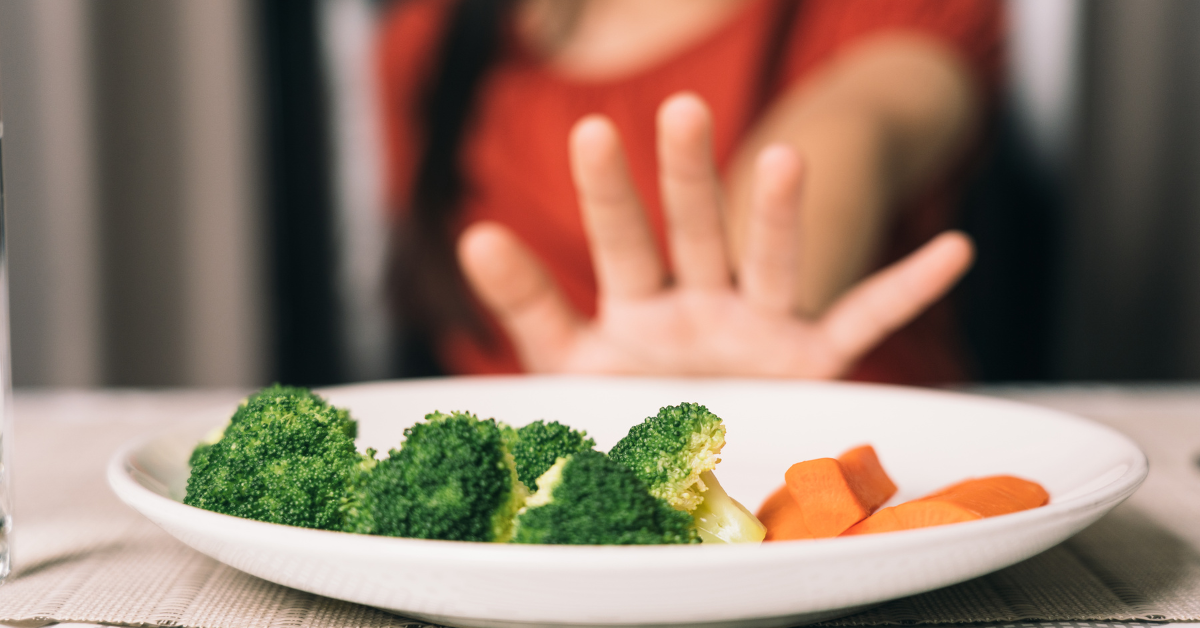166. When OCD Interferes with Eating. Could it be ARFID? with Brittany Braswell, RDN
In this episode, Carrie sits down with Brittany Braswell, a registered dietitian and host of Faith Filled Food Freedom podcast, to discuss a specific type of restricted eating that can be seen with OCD: Avoidant Restrictive Food Intake Disorder (ARFID).
Episode Highlights:
- The connection between OCD and disordered eating behaviors.
- What ARFID is and how it differs from other eating disorders.
- How OCD behaviors can worsen disordered eating patterns
- How fear, sensory sensitivities, and past experiences can contribute to restricted eating.
- The impact of disordered eating on physical, mental, and spiritual well-being.
- Practical strategies for overcoming food-related anxiety and finding food freedom.
Episode Summary:
In this episode of Christian Faith and OCD, I’m joined by Brittany Braswell, a registered dietitian and podcast host of Faith Filled Food Freedom. Brittany shares her expertise on a lesser-known eating disorder that’s closely tied to OCD—ARFID (Avoidant Restrictive Food Intake Disorder).
We dive into the challenges people with ARFID face, from sensory sensitivities to fears about eating certain foods. Brittany explains how this disorder, often misunderstood as just “picky eating,” can cause serious nutritional imbalances and impact both physical and mental health. This conversation is also helpful for anyone dealing with eating-related struggles linked to OCD, even if they don’t have a formal eating disorder diagnosis.
ARFID is more than just a fear of gaining weight. It’s driven by sensory issues, trauma, and irrational fears, such as choking or getting sick from food. Brittany and I talk about how these fears can escalate and affect a person’s relationship with food, leading to restrictive eating habits that can be emotionally and physically damaging. We also explore how ARFID often overlaps with OCD, especially when anxiety about food or body image becomes overwhelming.
If you or someone you love struggles with food-related anxiety or OCD, you’ll find valuable takeaways that can help break the cycle of fear and restriction.
This conversation is full of practical tips and biblical wisdom for anyone dealing with food issues, body image concerns, or eating compulsions.
Related Links and Resources:
More Episodes to Listen to:
Transcript
Carrie: Hello OCD Warriors, I am very excited to share today’s episode with you. We have an interview with Brittany Braswell, registered dietitian, podcast host of Faith Filled Food I brought Brittany Braswell on the show to talk about a very specific type of restricted eating that can be seen with OCD called ARFID.
However, even if you don’t have ARFID, but you have any type of eating struggles, Related to OCD. I know that there are several nuggets that you’re going to get out of this episode. So let’s dive in
Hello, and welcome to Christian faith and OCD with Carrie Bock. I’m a christ follower wife and mother Licensed professional counselor who helps christians struggling with OCD get to a deeper level of healing I couldn’t find resources for my clients with OCD.
God called me to bring this podcast to you With practical tools for developing greater peace, we’re here to bust through the shame and stigma surrounding struggling with OCD as a Christian, sharing hopeful stories of healing and helping you replace uncertainty with faith. I’m here to help you let go of the past and future to walk in the present abundant life God has for you.
So let’s dive right into today’s episode. Welcome, Brittany. Tell us a little bit about yourself.
Brittany: Thank you so much for having me, Carrie. I am a registered dietitian by Education and Trade, and I serve in my private practice with Christian women who struggle with disordered eating and negative body image.
So, we’re doing a lot of coaching around Fear foods, food freedom, body image, lots of unhealthy or disordered or intrusive thoughts around food and body. It’s kind of the gamut of it. I love it. It’s a really cool way for me to really take my love for the Lord and really use that to help the women that I work with really escape this place of fear and bondage around food and their body to get them hopefully to a place of freedom where their relationship to the Lord grows in the process.
Carrie: And I know that we’ve talked about there’s an overlap between OCD and individuals who have disordered eating, not all the time, but sometimes I was thinking of some clients, even then I was working with recently that have some hangups around food or have some ideas around food, like you said, that aren’t healthy or that are obsessive, maybe they’re obsessed with the kinds of foods that they’re eating or the amounts of foods that they’re eating people who weigh themselves all the time.
They’re weighing themselves just constantly, or like you said, in terms of body image, sometimes with OCD, they can be constantly checking themselves in the mirror. Yes. Yes. I see that a lot. Do I look fatter? And eating disorders are not my specialty, but I know that I wanted to have you on the show to see if we could talk a little bit about ARFID.
And I know you said that’s something you’ve worked with before, but you run the gamut and work with a much wider variety of eating challenges. Can you tell us maybe a little bit more broadly some of the things that you see?
Brittany: For a lot of the women and some men that I work with, not everyone has a diagnosed eating disorder.
If eating disorder freaks you out, just lay it to the side for a minute. And we’re really just focusing on behaviors that are going to negatively impact essentially your physical and mental health. These are going to be things like restrictive behaviors, meaning you are typically choosing to withhold food.
This is not, may I have lack of access. This is willful restriction. Right. There’s also a lot of different types of binging behaviors. And so. This is not always followed by purging, but that does happen as well. So binging would just be generally eating a larger amount of food in a shorter period of time than would typically be average or comfortable.
That’s kind of the high level view of that. And then lots of clients maybe struggle with purging in some way that can show up not just as making yourself sick, which a lot of people struggle with, but this might also be less recognized. But like, if you feel like, Hey, I just have to exercise, or if you notice you have a compulsion when it comes to movement or exercise.
That can be a form purging that can be really hard on your body, especially if you’re not adequately nourishing yourself. And there are lots of behaviors in between. I know we’re going to dive into RFID a little bit. There are lots of forms of restriction with that. I also love it because it’s a little bit more unique when it comes to the body image piece of things.
If you kind of just think about disordered eating on a spectrum from anything from very highly restrictive to I have no fullness cues or awareness around fullness levels and maybe there’s a lot of binging, kind of see the gamut, everything in between.
Carrie: Okay. What is ARFID? How would you define that? ARFID
Brittany: is an acronym and it stands for Avoidant Restrictive Food Intake Disorder.
The simple way to think about it is, it’s like picky eating on steroids. So often, it shows up initially, for a lot of people, we see it pretty often in kids, and young adults, or teenagers, but it can develop later, or it can get more severe later too, and OCD behaviors can, I hate to say compliment it, but they can kind of overlap.
At the same time, so kind of some of the differences in ARFID versus what most people kind of think about as a stereotypical eating disorder is you’re still going to have that lack of meeting adequate nutritional needs, usually with ARFID, because there’s a lot of restriction, but it’s not typically tied to, Hey, I’m afraid I’m going to gain weight, or I’m afraid my body’s going to change.
There could be a lot of different reasons for it. A lot of times it is sensory, meaning, hey, I’m afraid that, hey, if I eat this thing, I might coke, or if I eat this particular type of food, it might make me really sick, even though maybe I ate it not that long ago, maybe it’s going to make me sick now, or, hey, I’m really afraid this particular type of food because so and so told me it was bad, and so maybe it starts off as a fear food.
Then I’ve had clients that they won’t have an issue with food, but because they get so nervous about it, it’s like their body physically responds and it doesn’t settle well on their stomach. So then they think, Hey, I can’t tolerate it. Lots of times with ARFID, we see there’s not a lack of availability of food, but there is a lot of restriction, not just because of again, like body weight, body image, just a lot of.
Sensory issues and fears typically that contribute to, hey, I’m only going to eat this small handful of items, which you can kind of tell probably from that, you’re typically going to be pretty malnourished from a nutritional standpoint. Not malnourished in the sense of you may be eating enough, but you’re very likely missing out on a lot of key nutrients.
It can still affect your body physically and definitely your mental health as well.
Carrie: I wonder if this can start for people sometimes if they have had stomach issues, either related to anxiety or related to some type of illness, and then they’re afraid to eat certain things because it didn’t make them sick when they were ill, say with IBS or something else.
They’re afraid of having a negative reaction.
Brittany: Yes, I’ve seen that and I’ve seen it too from even just the acute, like, Hey, I ate the food at a restaurant once and I got food poisoning or it just didn’t sit well on my stomach. And so now I feel like I can’t ever have it again. So it can show up in lots of different ways getting started.
Carrie: How would people know that this is something that they’re struggling with? If, say, they only eat a certain number of foods or certain types of foods? How does that show up?
Brittany: I would say the amount that you eat or the particular foods you choose are going to vary person to person, but it is typically a much smaller variety of foods that you are comfortable consuming and that you are willing to consume.
And that’s different because as we work through a lot of the ARFID symptoms, sometimes there’s foods that, hey, I’m willing to eat that, I don’t love it, but I’m working on tolerance with it. I would say the three kind of big areas, you can kind of say, hey, do I have any red flies in this area? When it comes to prototypically, how does ARFID sort of present itself or show up is number one.
Do you have any textural type of sensitivities or selective sensitivity? So an example of this might be, Hey, I really don’t like foods that are smooth and creamy. It’s not just a preference, it’s, Hey, I have a particular response to this, or this particular food makes me like gag or get nervous, or I once choked on something that was crunchy and so I can’t eat crunchy foods now.
Being able to just think through like, are there any textures or even visually, I’ve, I’ve worked with some clients who visually, they really like everything to look the same. As an example of that, like, let’s say that’s going to really limit you on produce because it’s not every single strawberry. It’s going to look the same across the board, right?
Or apples. So apple juice might be more tolerable than fresh apples. So think about sensory kind of things. The second kind of area you could sort of self assess is, am I afraid something is going to happen when I eat this? It’s like a physical aversion. I’m afraid I’m going to choke or afraid I’m going to get sick or I’m afraid something terrible is going to happen.
We can bring in irrational fears and trauma into that too. It’s really easy for a trauma food Which is usually a food that you associate with a specific trauma event. It can be easy for those to turn into food aversions as well. The broader you go with it too, like let’s say, Say you were at Taco Bell and you have a particular trauma history or event that you associate with Taco Bell, then instead of just saying, okay, well, I’m not going to eat tacos anymore, okay, well, I can’t eat Mexican food, so now you’ve just taken lots of ingredients, right, and you’ve said, oh, I can’t have this this way.
So the more broad it shows up, typically the more restrictive you’re going to be. So that’s kind of the second area. So we’ve got sort of sensory issues or selectivity, fear of these aversive or negative consequences. And then sometimes in general, you get like this lack of interest in food or eating. It doesn’t even really sound good.
I think I only like these things. Unfortunately, that’s where sometimes physicians, especially parents and family, will just go, Oh, well, they’re just a really picky eater. You just do it. Just eat the thing. So sometimes there’s a lot of stress related to that, and it can actually push people further away even from wanting to or being willing to try new foods.
So that lack of interest shows up sometimes as well. So you can do a kind of a quick little assessment in each of those areas and just go like, Self check wise, are there anything? Any behaviors or thoughts or fears in any of these categories, maybe that present a red flag?
Carrie: Yeah, there’s a couple of things that I was thinking as you were talking about that.
One is that we have something in ICBT that we call living the fear that with OCD. So when you have something like, if you have a doubt, is this going to make me choke? Or am I going to get sick from this? Then all of a sudden, I mean, your throat may actually constrict a little bit. Which happens with anxiety.
A lot of people don’t realize that or your stomach may start to churn or you may start to feel discomfort there because of your anxiety response. It’s like telling your body how to respond. And I can imagine that if you’re very sensitive to your body and the noises it’s making. That can make this very challenging in terms of treatment.
Brittany: There’s a lot of different things that can absolutely come in play with that, where, again, we see a lot of the disordered eating and the OCD.
Carrie: The other thought I had about, is this something that can be similar to orthorexia, where you Only want to eat, quote, healthy foods, whatever you deem those to be,
Brittany: they can go hand in hand, but I would say typically the mindset behind each one is usually different because when it comes to orthorexia, oftentimes for someone who’s really full blown into orthorexia, and if you’re not familiar with this term, it’s essentially kind of this obsession with clean or healthy eating.
Oftentimes those struggling with orthorexia, the reason they’re choosing certain foods is because of a Either a desire or even a fear, they either have a desire to be a certain level of health and they think I can control my health if I eat this way, or I’m terrified that I’m going to be sick or I’m going to develop this illness if I don’t eat a certain way.
Or if I eat certain types of foods that are, the words I hear a lot are like, these are junk or these are unhealthy. We try when I’m working with clients to really get rid of a lot of the moralizing language around food. Yeah. Really pushes us into an unhealthy relationship with food most of the time. So yes, there can absolutely be some overlap, but I would say oftentimes people can fall into orthorexia and not even realize it because it frequently starts as, Hey, I just had this desire to eat more nourishing foods and to improve my physical health.
And then it can turn very quickly into a fear based again, kind of compulsion or desires that can absolutely be some overlap with OCD. It may just be a matter of working with someone to really get to the root and go, what initially contributed to the desire or the behavior showing up to see maybe which way it tends to lean a little bit more.
Carrie: That makes sense. Kind of getting behind the thought process that’s leading to the behaviors. Yeah. I’m wondering, as far as with the body sensation component of ARFID that we were talking about, Are there people who are uncomfortable with maybe even normal body sensations, like your stomach telling you that it’s full?
Maybe I have some strange fears. That is not a good thing.
Brittany: Yes, I don’t know how much you see that overlap when it comes to OCD, but I see that on a very regular basis with a lot of the clients that I have worked with, students that have been in my communities, is, Brittany, I don’t like the feeling of being full.
Either physically it feels uncomfortable. Or been told, if I feel full, then I ate too much. And so then there’s all this shame on, I broke this rule or I should have stopped at a certain point. Sometimes it comes more from the eating disorder side on, I’m afraid I’m going to gain weight. But oftentimes it comes back to this rule on, if I feel full, something’s wrong.
I did something wrong. I shouldn’t feel this way. And so one of the things that we can do with that, that I think is really helpful. And you can find them for free online or Carrie, I can give you a link. I’ve got one that I put together. I’m just looking at essentially like a hunger and fullness scale. We so often think about hunger and fullness is like, I’m hungry or I’m full, but it’s just like your bladder.
You can’t just say like, I do need to go to the bathroom or I don’t. You don’t all of a sudden, contrary to what my four year old will tell you on a road trip, like I didn’t have to pee until now and now I have to go. The same thing works with our hunger. It’s not just like, Hey, we’re totally fine. And then all of a sudden we’re famished.
Just like the same thing, like our bladder gradually fills over time, our hunger is going to gradually intensify. And same with our fullnesses, we’re going to gradually get more full. Even if you just like take a sheet of paper and draw a line left to right, horizontally, put zero on the left. 10 on the right and a 5 in the middle and go, okay, if 5 is totally neutral, not experiencing any mental or physical signs of hunger or fullness that are overtly noticeable.
And then 10 is like, I feel like I just ate Thanksgiving dinner twice over. 0 or 1 being like, I’m about to start crying because I’m so painfully hungry. There’s going to be a gradual step up or down all throughout the day. Even if starting from that point. Being able to say, again, got to do this without making them into rules on how can I only eat when I’m at this number and I have to stop when I’m at this number, but it can really help increase the awareness around, okay, if five is neutral, what does a three feel like for me, for me, if I give a personal example, that might be, okay, my stomach is kind of growling, I probably need to eat in the next 30 minutes, or I’m going to start getting a little hangry, I’m going to start being short tempered, Those kind of things.
And so you can start recognizing a little bit of hunger or mild hunger, moderate hunger. How does that change? And that can be just a helpful way to, instead of having that black and white mentality on I’m hungry or I’m not hungry, or I’m full or I’m not full going, How hungry am I? Or how full am I? And that can just kind of bring a little bit more awareness physically to where we are.
And then mentally, what thoughts tend to, it’s really interesting to start gaining awareness once you know physically where you are. What types of thoughts align with the different levels of hunger, of course, that you have, and that’s a great way to start increasing your awareness, your body awareness, or what I start teaching eventually is body trust and body wisdom so that you can trust your body again to be able to make decisions that help you feel nourished and you don’t feel so out of control around maybe certain foods or so fearful around others.
That’s the hungerfulness skills, a great place to start the awareness in that area.
Carrie: I think this is all really valuable, even if people don’t have ARFID, just to kind of be aware of, because there’s so much information, we have just an overload of information about health and what we should and shouldn’t eat, and like you said, It’s very easy when you’re dealing with OCD to be in a black and white thinking state.
Like, this is good food, this is bad food. I’m sure that you see that quite a bit. Tell us a little bit about how ARFID is treated.
Brittany: There are a lot of different ways. When it comes to our fed, and I think it’s so important here, if y’all don’t hear anything else, I say, I hope you will take this away that it is really multifaceted approach and that it’s so helpful to have somebody in the nutrition profession, but somebody in the therapeutic function as well, because it really is, it’s such a battle of.
Body and mind, because there’s a lot of exposure therapy. There’s a huge amount of exposure therapy with ARFID, meaning I’ve got to give myself the opportunity to eat these foods. But getting started, if that sounds like terrifying, like, Oh my gosh, you’re about to make me eat all these foods that I say I don’t like.
Oftentimes, it starts just with other sensory introductions to it, going, What does this food actually look like? Haven’t actually had this food on my plate in years. Or, the last time I had it, I choked and so I feel like I can’t have it again. Sometimes it doesn’t mean, hey, your first exposure, you need to eat a handful of grapes.
Maybe it’s I need to just wash some grapes and put them on my plate and just be okay with them. Or maybe I need to put them on my plate with some other foods and know that, Hey, if this food over here touches this food, we might have to challenge some rules there. Right. And so being able to just start with that and then looking at, okay, maybe from there we go to touch, we go, what does this food actually feel like?
The last time I had this, the crunch scared me. So what if I just crunch it with my fingers so I can see how easily it gives. What does it smell like? Does it really make me gag? Or maybe this particular food wasn’t prepared the same as this one. And so sometimes just having that initial sensory exposure for a little while can be really, really helpful.
I go back and forth on this a little bit, considering that I work with so many women who would classify themselves as, hey, I’m very type A and. They maybe tend to have a lot of rules or they get overly, they like to food journal a little too much, but sometimes food journaling can be really helpful when you’re doing these exposure activities to notice, again, with the awareness piece on, not just did I like it or didn’t like it.
That’s a really dangerous question to ask with foods because it’s really easy to go black and white and to write it off going, Nope, didn’t like it, but to be able to say, Hey, I could tolerate temperature of this. The warm chicken nugget from Chick fil A was much better than the room temperature one. Or I didn’t like the warm because it changed the texture.
I liked it better when it was ribbed up. And so being able to ask yourself more specific questions on what aspects of this did I like or did I not like? What aspects of it were tolerable? What would I be willing to challenge again? Being able to kind of get away from those yes or no answers can make them more subjective or more Open ended can be a really helpful place to start when it comes to those exposures.
Carrie: Let’s say somebody has been struggling with disordered eating for a while, and they’re concerned, or they have a loved one that’s concerned about, how do I know if this requires a higher level of care, like hospitalization, or some type of intensive outpatient, where would you say that line is?
Brittany: That’s a good question.
A lot of people like to say, go ahead and jump to, like, get your labs checked. I think more information is often helpful, maybe not in every situation. So some of the things I would say to watch for, number one, has the number of foods or the amount of foods that you’re consuming, like total volume consumed, as well as variety.
Have either one of those significantly changed, especially have either one decreased, it is not helpful typically to look at the scale first, because the scale may or may not change a whole lot as what you eat changes or as the volume changes. However, if you do start noticing clothing is feeling different or when I did go to the doctor, I had lost a fairly significant amount of weight in a short amount of time when that is unintentional, especially if it’s intentional, you need to come to me and have, we need to have another conversation.
But if it’s unintentional, it’s a good red flag to go out. Like I wasn’t trying to do this and what could have contributed to that. So unintentional weight loss. A reduction in the amount of food or the variety of food that you’re consuming. If you go, these don’t happen a lot. It’s not super common to just go get your labs taken on a regular basis, but even just having like a normal CBC kind of panel and just saying, Hey, can I get my basic labs checked so they can look at things like your electrolytes and your protein status, things like that, to make sure.
We’ve got to be medically stable when you’re not eating enough, your body temperature tends to drop, your blood pressure level changes. There’s a lot of signs that your body will give you, but I say that with the caveat that labs can’t tell the whole story either. So these are just all pieces of things that we want to look at.
And then I would say kind of maybe the last category that I would touch on here is. Hey, do I need help or do I need a higher level of care even? It’s really looking at a lot of have your fears around what you are consuming increased. People around you, are they able to lovingly point that out? Are you able to hear them?
And if you’ve been getting very defensive on, hey, no, no, I’m okay. It’s fine. But people are still, hey, it seems like you’re not eating. You ate this food last week, but this week you’re not. Being willing to hear that can be really hard. You have people around you that love you and support you and you start noticing them asking more questions about that.
It’s a really good red flag on maybe I need to get some extra support.
Carrie: Yeah, I think those are all great, great things to mention. Tell us a little bit about the Joy Filled Eater and How you work with clients, how people can find you.
Brittany: So the Joyfield Eater Lab is the group coaching program that I run for Christian women who are really just ready to break free from negative body image and disordered eating.
And this is the group where we kind of have a rolling enrollment. So you come in and for six months you get weekly coaching calls. We meet twice a month to do kind of Q and A and we talk through the course content and the models you get access to. And then twice a week, if you’re one of those people who’s like, I want to do it, but sometimes I don’t make time to do it.
Twice a month, we have co working calls. And so we all hop on and we work their content together. We implement, we have clients that will sometimes do their fear food challenge, like on a call. Um, and so it just gives you that extra little bit of support or accountability to say, Hey, here’s what I’m going to work on for the next 30 minutes.
And then. We all turn off our cameras or mute our mics and we do the work and then we hop back on and you get to say, Hey, here’s what I finished. So we do that. And it’s a lot of fun. It gives you an opportunity, not only to get the educational side of things and the coaching, but to also develop some community because anytime you have anything that you struggle with, especially when it’s that physical mental combination, it’s hard sometimes to talk about and to find people who really get it.
So it’s a fun place to be able to build community with like minded women who. Understand what you’re going through and we keep confetti on my desk. So we throw confetti to celebrate, to celebrate the wins every week on our calls. So if you need a confetti moment, y’all come, come join us at the Joyful Leader Lab.
Carrie: Hey, that’s awesome. We all need more confetti moments in our life. I talk a lot about celebrating the small successes, and if you were able to eat something that you were terrified of eating, then that is awesome. It’s really great. It is awesome. Progress. Well, thanks so much for coming on the show. Um, it’s been a great conversation.
I hope that you enjoyed today’s interview, and just know I am always looking for guest suggestions or people to interview. If you would like to come on the show and tell your personal story of OCD, I am hoping to record some of those this spring to air them over the summer, if I can get enough people who are willing to do that.
You can reach us with any of those guest suggestions at kerrybach. com slash podcast. If you used to get emails from us and have found that you are no longer receiving those, I really want to ask you to check your spam folder. I won’t bore you with the technical reasons, but we had some issues earlier this year, and now less and less people are actually opening and reading the emails.
So if you’ve been missing out thinking I wasn’t sending them, I am still sending them every week. Just double check your spam if you’re not receiving them. To receive weekly encouragement, find out about our monthly Meet the Podcast host Zoom meetings, and receive information on exclusive sales, become an email insider today.
All you have to do is go to carriebock.com and scroll towards the bottom of the page. You’ll find a spot to put in your email and receive a free download in your inbox from us. Until next time, may you be comforted by God’s great love for you.
Christian Faith and OCD is a production of By The Well Counseling. Opinions given by our guests are their own and do not necessarily reflect the views of myself or By The Well Counseling. This podcast is for informational purposes only and should not be a substitute for seeking mental health treatment in your area.








